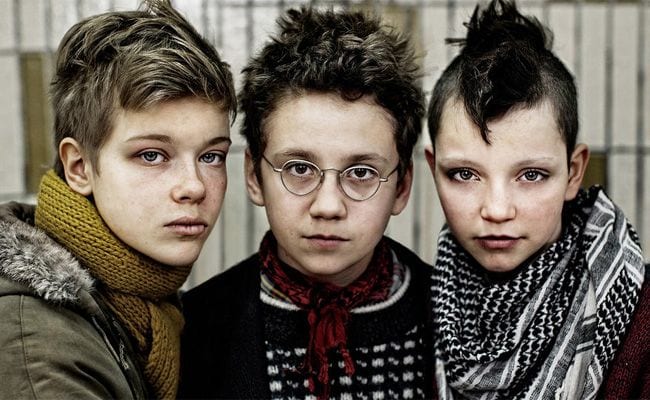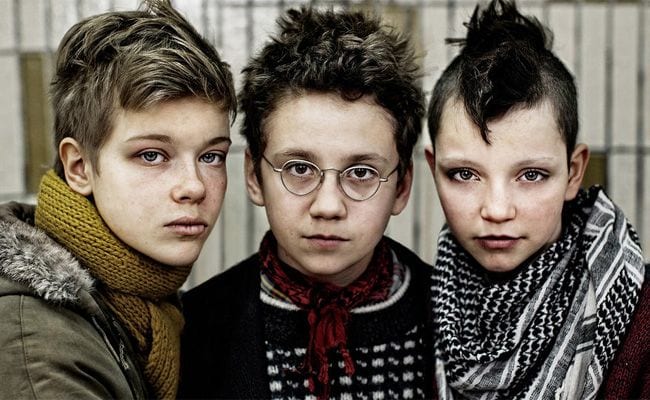
Above: Lead actors Liv LeMoyne, Mira Barkhammar, and Mira Grosin. Photo: Memfis-Film / P-A Jörgensen
Lukas Moodysson’s We Are the Best! (Vi är bäst!) starts on a scene showing the adult world and then zooms in to find its barely-teenage protagonists. This visual technique, used several times, locates Bobo (Mira Barkhammar) in a sea of guests mingling at her parents’ house. By framing the movie’s central characters with cut-off grown-up bodies, Moodysson emphasizes the smallness of their world.
Bobo’s particular small world consists mainly of one other person, Klara (Mira Grosin), who sports a sort-of mohawk and espouses punk-rock philosophy. The girls, growing up in 1982 Stockholm, bond over their outsider status, enacting rituals of rebellion in sync, dressing androgynously, rolling their eyes at their gym teacher’s reprimands, and revering punk even though they’re told that the genre is dead.
Eventually they take their musical obsessions to the logical conclusion and form a band at their local community center, despite knowing nothing about playing music. They write lyrics for a song called “Hate the Sport” — vilifying their gym class, naturally — and attempt to bash out a rhythm and melody, to little avail. Neither the brash Klara nor the moodier Bobo discovers hidden abilities.
At least, not their own abilities. They do take notice of their classmate Ludvig (Liv LeMoyne), a quiet, religious girl who knows her way around a guitar. After Ludvig shows off her skills at a school talent show (receiving plenty of boos from the unforgiving crowd), Klara and Bobo aggressively recruit her for friendship and music, not necessarily in that order. Klara employs particularly confrontational tactics with her new friend, attempting to cure Ludvig’s belief in God through rock music and haranguing arguments, and insisting on cutting her long blond hair into a less traditional shape. The result of that experiment throws their emerging bond into jeopardy, briefly.
We Are the Best! understands that parents and children can panic over a haircut, and understands equally well that such tensions can be dissolved into fits of giggles and horsing around. The movie features several of these near-vignettes. Moodysson, adapting an autobiographical comic book by his wife Coco Moodysson, stays true to the characters’ lives by not imposing a needless plot. The three girls maintain a vague goal of getting their makeshift band in good enough shape to play a short set at another local venue. But before that can happen, they need to play their single original composition correctly, all the way through.
But this is not a movie about kids learning the value of intense practice and dedication. Instead, it’s a movie about the major and minor tumults of growing up. The visual energy creates smooth transitions through crises that mutate into triumphs and vice versa, and Moodysson gets Klara, Ludvig, and Bobo’s youthful impetuousness just right. In one sequence, they jump from desperately needing their own musical instruments (rather than the community center’s stock equipment) to begging for money from strangers to really needing a snack.
These whiplash transitions and displays of bravado generate laughs, and for this reason We Are the Best! might be called a comedy. But the film takes the girls seriously, too, with deft and sometimes unflattering portrayals of Klara’s bratty tendencies (she disdains her sweet, levelheaded, and open-minded parents) alongside Bobo’s insecurities, which emerge when the trio goes on what turns out to be a lopsided group date with some boys in a punk band. By de-emphasizing usual narrative stakes, Moodysson gives his cast lots of room to explore behavioral details. All three young actresses are terrific, performing with the kind of unguarded, unaffected naturalism that sometimes seems unthinkable in American movies.
Despite eschewing a typical school-of-rock arc, the portraits and episodes of We Are the Best! build to a wonderfully satisfying climax that, in perfect coming-of-age fashion, solves everything in the moment and almost nothing in the long run. The movie squeezes real joy out of this contradiction, melding resolution and open endings together like musical genres that shouldn’t fit, like the lingering of low-key noodling somehow played with the urgency of punk rock.


![Call for Papers: All Things Reconsidered [MUSIC] May-August 2024](https://www.popmatters.com/wp-content/uploads/2024/04/all-things-reconsidered-call-music-may-2024-720x380.jpg)



